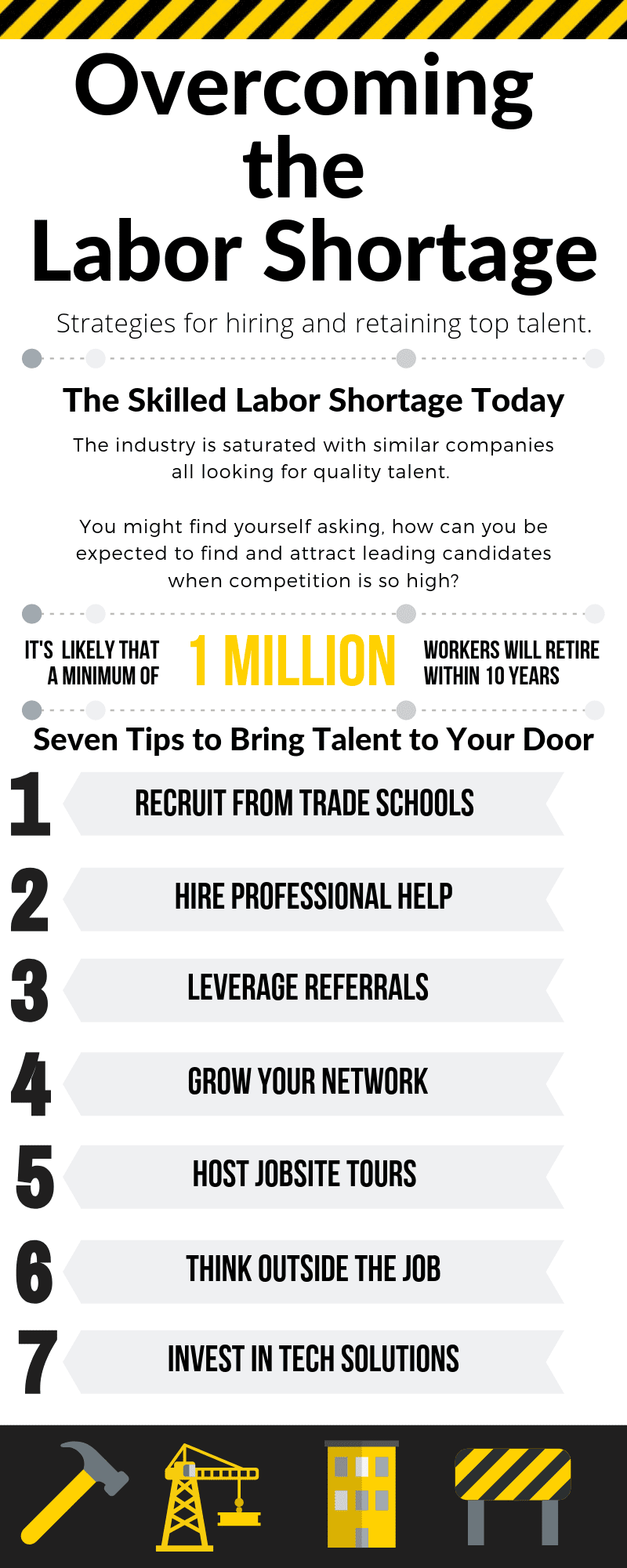Every construction business owner and manager understands the high cost of keeping people who can’t do the job onboard and then having to pay out to replace them. But have you ever wondered what employee turnover rates cost you when you lose people who can do the job?
It turns out there are more costs associated with employee turnover than you might have realized, and many of them are hard to track because they are indirect or intangible.
This Turnover Doesn’t Taste Good At All
The ADP Workforce Vitality Index reported a Job Turnover Ratio of 26.5% across all industries. Construction’s turnover rate was 21.4%, showing little change over the past seven quarters.
The ADP Workforce Vitality Index reported a Job Turnover Ratio of 26.5% across all industries for the first quarter of 2017. Construction turnover rates were 21.4%, showing little change over the past seven quarters. The statistic is especially telling as it reflects actual job changes, not retirements or people dropping out of the labor force.
Construction’s rate of employee turnover is higher than four other tracked industries but lower than five. Employee turnover in the first quarter of 2017 was highest in the South, followed by the West, the Midwest, and the Northeast. The very young, 24 years old or younger, had the highest turnover rates at almost 64%. Those aged 25-34 had the second highest turnover rates at almost 30%, followed by 35-54 (17.5%), and 55 or more (10.7%).
One of Every Five Are Leaving
Companies with 50 or fewer employees, the lion’s share of construction companies, registered yearly turnover rates of 24.2%, the lowest of all company sizes, except the ones with 1,000 or more employees.
But, when you consider that about one in five construction workers successfully changed jobs in the first quarter of 2017, you can begin to appreciate the cost born by construction firms.
At the same time, workers are not really coming out much better in the pay department through all the employee turnover. For the first quarter of 2017, workers in construction who changed jobs increased their earnings by less than two percent.
Employee Turnover Costs in Hard Numbers
So, what are the costs of employee turnover in construction? According to a widely cited source, the Center for American Progress, the average turnover rate varies based on the person’s position and whether they are on salary (exempt) or hourly wage (nonexempt).
Replacing employees you pay a low hourly wage to will cost you 16% of their annual base pay. So, if you have a laborer you are paying $10 per hour, replacing them will cost you $3,200 ((10 x 2008) x .16).
The cost goes up to 20% of a mid-level employee’s annual salary. When it comes to executives with specialized skills and education costs may go up to 213% of annual salary. In all cases, it takes a lot of work to replace someone, and work has costs.
You’ll have to do:
- The work needed to exit the employee, including time spent doing necessary paperwork, closing out security credentials, arranging for temporary coverage of the person’s job, notifications to vendors/project participants, changes to company directories, changes to customer-facing documents and final accounting chores.
- The work needed to hire a replacement, including assessing the job description, publishing the job, working with recruiters and job boards, doing the interviews, screening applicants and doing the necessary hiring tasks.
- The work needed to orient the replacement, including necessary safety training, systems training, process training, introductions to teams, skills assessment, initial work evaluations, not to mention productivity losses while the person gets up to speed.
- The work needed to overcome the early mistakes the replacement has made, and the time for the replacement to forge effective working relationships with company employees, subs, vendors and others.
- The work needed to truly understand why the employee left, and to come up with ways to prevent that from happening again.
The Softer Side of Employee Turnover Costs
When an employee jumps ship there are also intangible costs. Relationships are key aspects of construction project success. For example, when you lose a superintendent who knows your subs and has worked with them on many projects, you lose a relationship connection. It’s difficult to quickly replace that type of corporate knowledge.
The relationships the superintendent forged were likely responsible for teamwork, camaraderie, and getting the job done under trying conditions.
The relationships the superintendent forged were likely responsible for teamwork, camaraderie, and getting the job done under trying conditions. They knew what motivated your team members and the subs. If they were successful, they had the respect necessary to instill loyalty and trust. And there were ‘understandings’ between them and other project participants that helped to keep things on an even keel, even in the face of the most challenging circumstances.
There is also a value proposition about employee turnover that is hard to measure but has a profound impact on an organization. Over time, many employees increase their value to the organization as they “figure it all out” and understand how to work within the company’s culture and how to effectively interact with company partners and customers. Some employees who work well with customers bring the added value of positive word of mouth. That boosts the company’s reputation and helps with sales.
You Might Not Realize What You’re Really Losing
A construction businesses’ greatest value lies in its people, and when the long term viability of the company’s leadership is questionable, the company loses its competitiveness.
While some help boost morales with their infectious enthusiasm, a lone wolf, a detail-oriented nerd, provides deep answers to questions nobody else is even thinking about. When such a person leaves, you can’t tabulate the losses on a spreadsheet in hard numbers, even though there is still a loss. And many times a loss like that takes longer to get over than recouping all the measurable dollar costs.
Another thing you need to pay for is the damage to the company hierarchy and continuity. If the person leaving was in line to fill a position that you expect to go vacant, because of retirement for instance, you end up having two positions to fill. This challenges business continuity, if the person leaving was slated for a position enabling an owner or a CEO to retire. A construction businesses’ greatest value lies in its people, and when the long term viability of the company’s leadership is questionable, the company loses its competitiveness.
The greatest danger of employee turnover is when companies go on their merry way totally oblivious to what it’s costing them. That’s when high employee turnover becomes the norm.

Research suggests that by 2020, 31 million skilled tradespeople will leave the industry, costing nearly $100 million in lost productivity over the next five years. Check out The Ultimate Guide to Beating Construction’s Skilled Labor Shortage ebook to get expert tips on how to survive —and thrive—during the labor shortage.

Duane,
How did you establish your formula for calculating the cost for employee turnover? What do each of these variables mean?
I suspect there are a lot of companies that could use this analytic tool to help them calculate the cost of their turnover. And I’m interested in helping,
John Killingsworth
Colorado State University